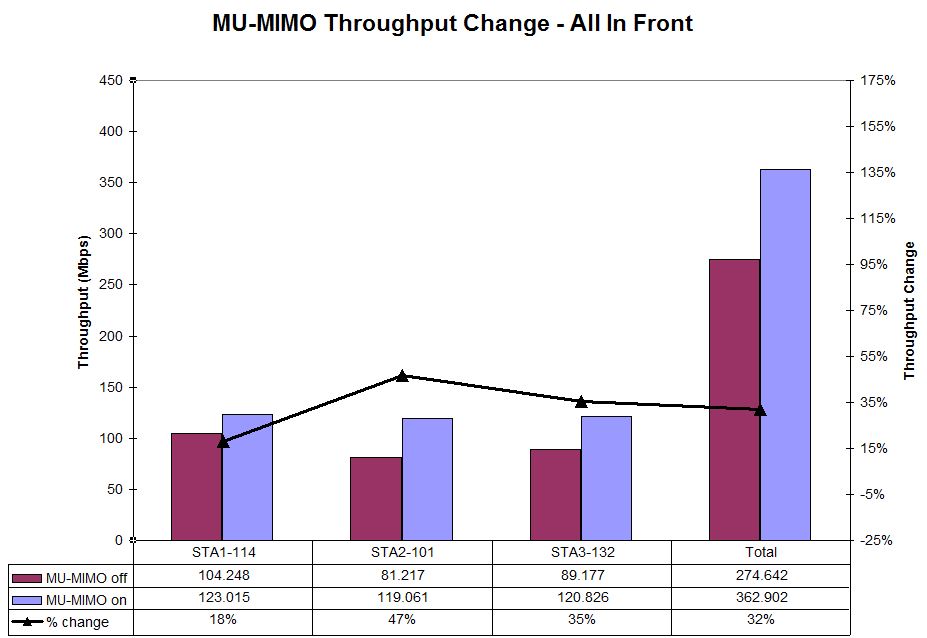That's QCA marketing-speak for its MU-MIMO chipset.Any technical details or insights of this so called Qualcomm® VIVE™ with MU | EFX ?
Didn't see it in the review about it.
Go here if you want the full marketing treatment.
That's QCA marketing-speak for its MU-MIMO chipset.Any technical details or insights of this so called Qualcomm® VIVE™ with MU | EFX ?
Didn't see it in the review about it.
Stopped by Fry's this morning over at Stoneridge/Aero Drive off the I-15 (San Diego), and they have EA8500's on the shelf at $279...
The performance of the MU-MIMO router does seem impressive. I do wonder what does MU-MIMO bring to the table if you have a couple of two-stream MU-MIMO clients.
The EA8500 was most impressive when used with multiple clients (I used five clients in my testing) of different Wi-Fi tiers, including single-stream (1x1), dual-stream (2x2) and three-stream, at the same time. First of all, I noticed that in this case, most clients were consistently indicated to be connected to the router at their max speeds, which were 1.3Gbps, 867Mbps and 433Mbps for 3x3, 2x2 and 1x1 clients, respectively. This was new; with all other 802.11ac routers, the clients' indicated connection speeds always fluctuated a great deal. Secondly, the real-world speed of each client when the router was hosting all of them was, for the most part, the same as when the router was working with just one of them. Furthermore, the clients took a very short time to connect to the router.
This clearly was the indication that MU-MIMO indeed improved the overall performance of a mixed network. Note that of five devices I used with the router for testing, only three of them featured a Wi-Fi adapter that also supported MU-MIMO.
Every day I learn something. One thing I learned from reading this review is that there are going to be single-stream 802.11ac adapters installed in laptops. For some reason, I thought that after the wireless-n fiasco, the hardware manufacturers will be required to use two stream wireless-ac adapters in laptops. (the fiasco by which the greedy hardware vendors loaded those garbage single-band single-stream wireless-n adapter into every PC, laptop, and even many business class notebooks and workstations sold at BestBuy and elsewhere). Granted, at least the single-stream ac is still capable of ~400Mbps link rate, which is above the speed of the two-stream N300 hardware.
Unless I totally miss that, the reviewer from CNET did not disclose the clients cards he used for his test? especially the mu-mimo one?Cnet tested the router with five clients, three of which had MU-MIMO adapters in them. Here's a portion of the review:
Full review here:
http://www.cnet.com/products/linksys-ea8500-max-stream-ac2600-mu-mimo-gigabit-router/
Because laptops and tablets with MU-MIMO enabled radios won't be out until July, Linksys and QCA had to gin up MU-MIMO enabled laptops and include them in the reviewer's kit. The box from Linksys contained three Dell Inspiron 13 7000 Series 2-in-1 laptops (7348, Early 2015) with QCA-sourced 1x1 AC MU-MIMO enabled wireless card installed. The laptop configuration ordered had a 2.2 GHz Intel Core i5-5200 CPU with 8 GB RAM running Windows 8.1 Pro 64 bit.
These laptops usually come with a 2x2 Intel Dual Band Wireless-AC 7265 + Bluetooth 4.0 card. Device properties for the substitute QCA adapter identified it as Qualcomm Atheros QCA9377 Wireless Network Adapter using a 11.0.0.526 driver. The adapter properties didn't include any references to MU-MIMO, beamforming, band selection or bandwidth selection. This card is not and will not be commercially available.


Was away this week. You'll see it sometime next week.@ Tim Higgins - any news on the regular review aspects of this device thru the standard test plan?
Have you had a chance to do more testing with the EA8500? I'm noticing that LAN ping times start increasing with network traffic which may account for some delays seeing on network TCP communications. Can MU-MIMO scheduling somehow overflow onto LAN devices?Was away this week. You'll see it sometime next week.
I have done that. I want to make sure someone else is seeing the delays so I can be sure it's not just isolated my test network.My testing would not catch that, chadster. Why not report your results directly to Linksys since you have a direct relationship with them?



Welcome To SNBForums
SNBForums is a community for anyone who wants to learn about or discuss the latest in wireless routers, network storage and the ins and outs of building and maintaining a small network.
If you'd like to post a question, simply register and have at it!
While you're at it, please check out SmallNetBuilder for product reviews and our famous Router Charts, Ranker and plenty more!
